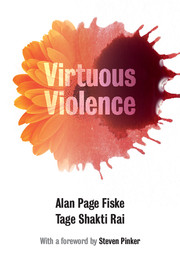Book contents
- Frontmatter
- Dedication
- Contents
- Figures and tables
- Foreword
- Warm thanks
- The point
- 1 Why are people violent?
- 2 Violence is morally motivated to regulate social relationships
- 3 Defense, punishment, and vengeance
- 4 The right and obligation of parents, police, kings, and gods to violently enforce their authority
- 5 Contests of violence: fighting for respect and solidarity
- 6 Honor and shame
- 7 War
- 8 Violence to obey, honor, and connect with the gods
- 9 On relational morality: what are its boundaries, what guides it, and how is it computed?
- 10 The prevailing wisdom
- 11 Intimate partner violence
- 12 Rape
- 13 Making them one with us: initiation, clitoridectomy, infibulation, circumcision, and castration
- 14 Torture
- 15 Homicide: he had it coming
- 16 Ethnic violence and genocide
- Chapter 17 Self-harm and suicide
- 18 Violent bereavement
- 19 Non-bodily violence: robbery
- 20 The specific form of violence for constituting each relational model
- 21 Why do people use violence to constitute their social relationships, rather than using some other medium?
- 22 Metarelational models that inhibit or provide alternatives to violence
- 23 How do we end violence?
- 24 Evolutionary, philosophical, legal, psychological, and research implications
- The dénouement
- References
- Index
3 - Defense, punishment, and vengeance
Published online by Cambridge University Press: 05 December 2014
- Frontmatter
- Dedication
- Contents
- Figures and tables
- Foreword
- Warm thanks
- The point
- 1 Why are people violent?
- 2 Violence is morally motivated to regulate social relationships
- 3 Defense, punishment, and vengeance
- 4 The right and obligation of parents, police, kings, and gods to violently enforce their authority
- 5 Contests of violence: fighting for respect and solidarity
- 6 Honor and shame
- 7 War
- 8 Violence to obey, honor, and connect with the gods
- 9 On relational morality: what are its boundaries, what guides it, and how is it computed?
- 10 The prevailing wisdom
- 11 Intimate partner violence
- 12 Rape
- 13 Making them one with us: initiation, clitoridectomy, infibulation, circumcision, and castration
- 14 Torture
- 15 Homicide: he had it coming
- 16 Ethnic violence and genocide
- Chapter 17 Self-harm and suicide
- 18 Violent bereavement
- 19 Non-bodily violence: robbery
- 20 The specific form of violence for constituting each relational model
- 21 Why do people use violence to constitute their social relationships, rather than using some other medium?
- 22 Metarelational models that inhibit or provide alternatives to violence
- 23 How do we end violence?
- 24 Evolutionary, philosophical, legal, psychological, and research implications
- The dénouement
- References
- Index
Summary
[Injun Joe and the Spaniard, hiding in the dark outside the home of the Widow Douglas – Injun Joe speaks first]
“I tell you again, as I’ve told you before, I don’t care for her swag – you may have it. But her husband was rough on me – many times he was rough on me – and mainly he was the justice of the peace that jugged me for a vagrant. And that ain’t all. It ain’t a millionth part of it! He had me horsewhipped! – horsewhipped in front of the jail, like a nigger! – with all the town looking on! Horsewhipped! – do you understand? He took advantage of me and died. But I’ll take it out of her.”
“Oh, don’t kill her! Don’t do that!”
“Kill? Who said anything about killing? I would kill him if he was here; but not her. When you want to get revenge on a woman you don’t kill her – bosh! you go for her looks. You slit her nostrils – you notch her ears like a sow!”
“By God, that’s ———”
“Keep your opinion to yourself! It will be safest for you. I’ll tie her to the bed. If she bleeds to death, is that my fault? I’ll not cry, if she does.”
Mark Twain, The Adventures of Tom SawyerDefense and punishment
Most contemporary theories of violence implicitly limit their scope to violence that the theorist unreflectively construes as illegitimate: that is, most are attempts to explain “bad” violence (Betz, 1977). But there are two constitutive phases of violence that, in varying forms and degrees, are almost universally recognized as morally acceptable, justified, and even obligatory: protection in the form of defense and redress in the form of punishment. Yet most theories of “violence” exclude or simply ignore defense and punishment, providing no explanation for them or not integrating the account of them into the overall theory of “violence,” which is a priori defined to exclude them.
- Type
- Chapter
- Information
- Virtuous ViolenceHurting and Killing to Create, Sustain, End, and Honor Social Relationships, pp. 35 - 41Publisher: Cambridge University PressPrint publication year: 2014

